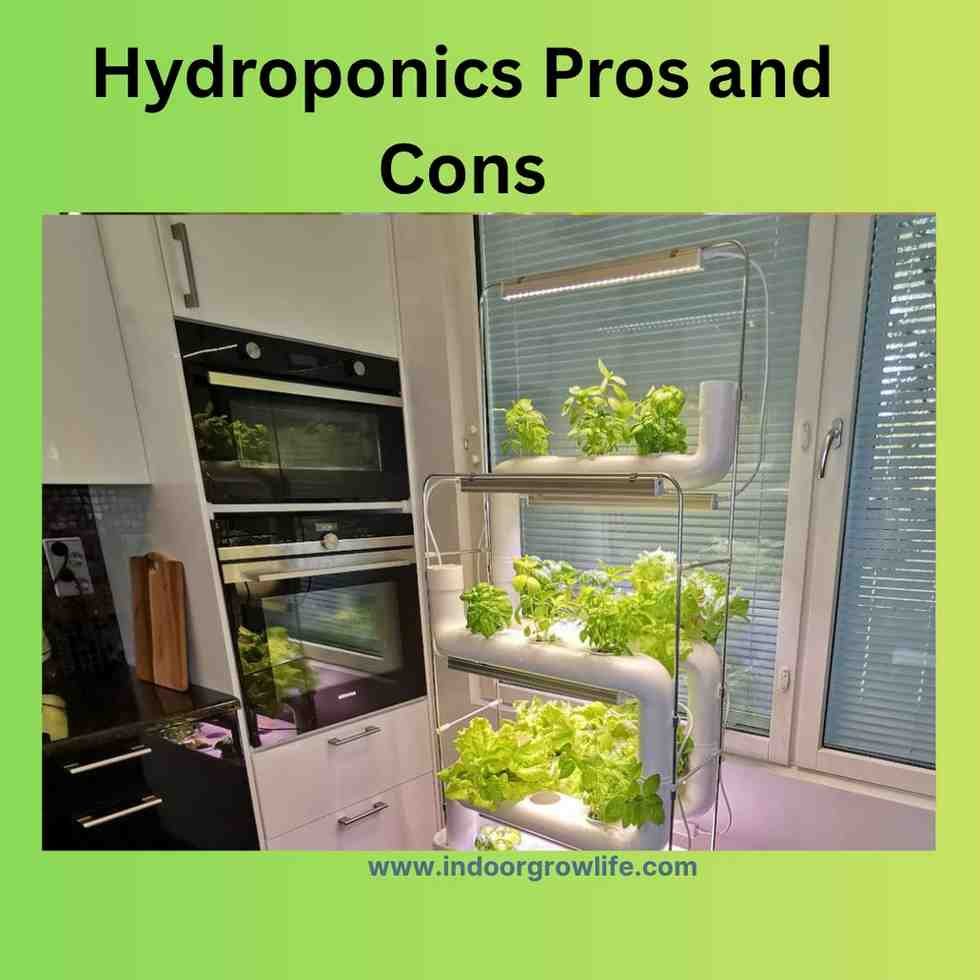Growing in bad soil can be a real pain, sometimes. Maybe you’ve hauled compost, fought off bugs, or watched your tomatoes shrivel in the summer heat. That’s why folks turn to hydroponics, but even then, it’s fair to ask: What’s the point of hydroponics, really?
I’ve run both soil and hydro systems here on our homestead, where the dry season hits hard. In this post, I’ll walk you through hydroponics advantages and disadvantages so you know what you’re getting into.
You’ll learn when hydro’s worth it, when it’s not, and what you should think about before jumping in.
What’s the Point of Hydroponics?
Hydroponics is a method of growing plants in water instead of soil. It helps address common gardening challenges like poor soil quality, limited space, and extreme weather. Hydro systems deliver nutrients directly to the roots, which often leads to faster growth, higher yields, fewer pests, and up to 90% less water use compared to traditional soil gardening.
While it offers big advantages, like cleaner produce, better control, and year-round growing, it’s not foolproof. Some setups require frequent monitoring, especially for crops like tomatoes. Choose a system that fits your space, time, and experience level.
When matched well, hydroponics can be an efficient and rewarding way to grow food, even in a city apartment or in tough climates.
What’s Hydroponics?
Hydroponics simply means growing plants in water instead of dirt. The roots sit in water mixed with nutrients, and the plant pulls up everything it needs without having to dig through soil.
There are different types of systems, and I explained the differences in this post. Some, like Deep Water Culture (DWC), keep the roots in a big tub of water. Others, like Nutrient Film Technique (NFT), run a thin stream of water across the roots in channels.
There’s also ebb and flow, where water floods the roots on a schedule and drains away. Immerse yourself in that post to learn the hydroponic system I recommended for absolute beginners.
Hydroponics Benefits: 8 Reasons to Give It a Shot
Hydroponics isn’t just some high-tech novelty. It’s a practical solution for anyone dealing with poor soil, limited space, or unpredictable weather. Here’s what makes hydroponic growing so appealing:
1.Faster Growth
Plants grown hydroponically tend to grow faster than those planted in soil. According to a study published in the International Journal for Multidisciplinary Research, the direct delivery of nutrients to the roots, without needing to search through soil, gives plants a serious head start.
I’ve personally noticed this with crops like lettuce, herbs, and leafy greens, which often go from seed to harvest days or even weeks quicker.
You’ll see faster growth. Plants don’t waste energy spreading roots looking for food; it’s already there. One study in a post I wrote previously about soil vs hydroponics gardening claims that hydro plants can grow 30-50% faster than traditional soil farming.
2.Higher Yields: More Food Per Square Food
One PubMed Central article says that hydroponics can produce more food per square foot than traditional soil-based systems. With the ability to give each plant exactly what it needs when it needs it, you end up with stronger, more consistent harvests. This is one reason many commercial growers are investing so heavily in hydro setups.
3.Way Less Water Use
Hydroponics can cut water usage by up to 90% compared to soil gardening, according to a PMC review on sustainable crop production. Instead of soaking into the ground or evaporating, water is recirculated through the system. That means you’re not just growing smarter; you’re conserving water while you do it.
4.Better Control Over Growing Conditions
One of the biggest wins with hydroponics is the overall control you get. The IJFMR study cited above highlights how growers can dial in everything: temperature, humidity, pH, and nutrient levels. This tight control leads to healthier plants and fewer surprises, especially in places where outdoor conditions swing wildly.
5.Grows More in Less Space
If you’re like a lot of folks today, you live in a city apartment and don’t have much room. The idea of a garden can seem like something only families who live deep in the sticks can actualize. The good news is that hydroponics works even in tight spaces.
The PMC article above explains how vertical farming lets you grow upward instead of outward, using shelves or towers to maximize every square foot. It’s perfect for city dwellers or anyone with limited backyard space.
6.Fewer Soil Pests and Diseases
Since hydroponics skips the dirt, you avoid a lot of the common problems that come with it. Per the PMC article above, many soil-borne pests and diseases don’t show up in soilless systems. That means fewer issues with bugs and fungus, and a lot less need for chemical treatments.
7.Grow All Year Long
With hydroponics, seasons don’t matter nearly as much. Hydro systems allow for steady, year-round production indoors, no matter what the weather’s doing outside. This is especially handy in areas with harsh winters or brutally hot summers where outdoor growing just isn’t realistic year-round.
8. Better for the Environment
Hydroponic systems are designed to recycle nutrients and water, which reduces runoff and pollution. A research paper on nutrient recycling explains how this closed-loop approach makes hydroponics a more environmentally responsible way to grow, especially compared to traditional farming that can lead to fertilizer leaching into waterways.
Hydroponics isn’t for everyone, but when it’s done right, it’s efficient, clean, and incredibly productive. Whether you’re growing in a basement, a greenhouse, or a sunny windowsill, it gives you the kind of control most soil gardeners can only dream of.
Disadvantages of Hydroponics
It costs a lot to get started with hydroponics-Setting up a hydroponic system takes a big upfront investment. You need special equipment, materials, and ongoing maintenance. And that can be too expensive for a lot of people.
Hydroponics relies heavily on electricity-These systems need power 24/7 to keep pumps, lights, and temperature controls running. If the power goes out, even for a short time, that situation can seriously hurt or even kill your plants.
You need to know what you’re doing-And pay close attention too. Hydroponics isn’t one of those set-and-forget projects. It takes a good understanding of nutrients, water chemistry, and how the system you have works. You have to keep an open eye on things, or you won’t like the results very much.
Diseases can spread fast through the water-The water gets reused and shared between plants. So if one plant gets sick, it’s easy for the disease to spread to all the others, according to this article in the Global Journal of Agricultural and Agricultural Sciences.
Diseases can spread fast through the water-The water gets reused and shared between plants. So if one plant gets sick, it’s easy for the disease to spread to all the others, according to this article in the Global Journal of Agricultural and Agricultural Sciences.
If something goes wrong, your plants can suffer right away-There’s no soil to act as a backup, so if the system stops working, (like if the water flow or nutrients are off), plants can get stressed or die really quickly. With hydroponics, you get the results you deserve (for the most part) real quick.
You have to buy specific nutrients and parts-Hydroponic systems need certain kinds of nutrient mixes and components, and sometimes they’re hard to find or expensive. That makes you more dependent on suppliers, which doesn’t great when you’re trying to become food secure.
Environmental concerns-If synthetic nutrients or chemicals aren’t handled properly, they can pollute the environment, especially nearby water sources.
Water and electricity don’t always mix safely-Hydro systems use a lot of water and electrical equipment at the same time, which can be dangerous if something breaks or malfunctions. Fortunately, there’s always a practical remedy for each of these demerits.
It’s Not a One-Size-Fits-All Setup
The system you pick and how much work it takes really depends on what you’re growing, how big your setup is, and how much attention you want to give it.
Let me break it down with a few examples:
I’ve got lettuce in a basic storage bin (Kratky method) that I can leave for weeks. No pumps, no timers, just fill it up and let it grow.
But when I grow full-sized tomatoes in a small bucket, I’m changing the water every week. They feed fast, and you can actually watch the water change color, from a reddish tint on day one to nearly clear by the end of the week.
Some folks run NFT systems for greens with timers and barely touch them. Others use deep reservoirs to cut back on maintenance, but that can mean more wasted water if it’s not dialed in.
What Makes a Difference:
- Reservoir size: Bigger ones mean more stable temps and nutrients, but also more upfront cost and possible waste.
- Water quality: You’ll want to test pH and EC more often.
- Crop type: Leafy greens and herbs are easy to grow. Fruiting plants like peppers or tomatoes need a bit more monitoring.
- System type: Kratky is super hands-off. Ebb and flow needs power and timers, and DWC sits somewhere in the middle.
So hydroponics gardening isn’t always “set it and forget it,” but it can be lower-maintenance than fighting bad soil, bugs, and heat, especially in places like Texas or southern Arizona, where outdoor gardening can feel like endless battles.
Why You Might Not See Benefits of Hydro Grows
If you’re growing food indoors as a hobby, the full benefits of hydroponics might not hit you right away. And honestly, that’s something I see a lot of indoor growers not mentioning.
Commercial farms use hydro to maximize space, speed, and efficiency. They’ve got engineers tweaking nutrient levels, full IPM (integrated pest management) protocols, and giant greenhouses that run like clockwork.
Now take that and shrink it to a shelf in your garage. Suddenly, things shift. For example, many home growers (myself included, early on) go for a big reservoir thinking it’ll make life easier. And it does.
Your system’s less likely to overheat or run dry, but now you’re dumping gallons when it’s time to change water or fix a nutrient mix that’s gone off. So the water-saving benefit’s all but gone.
On Reddit, one grower shared how they had tomatoes in a small bucket and had to swap out the water weekly just to keep up.
Meanwhile, their lettuce in a bin sat untouched for weeks. That’s a pretty clear picture of how plant type + system size = your workload.
The trick is to match your system to your lifestyle.
- If you want low maintenance, grow leafy greens in a tote.
- Got time to monitor nutrients and water temps? Try tomatoes in DWC or ebb and flow.
Hydro works, but only when the setup fits your time, your space, and your goals. That’s something you won’t always hear many websites mentioning.
Final Thoughts
Hydroponics isn’t magic, but when it fits your space and your goals, it can be a smart way to grow.
It’s cleaner, faster, and more controlled than soil gardening, especially if your local dirt is a mess or your climate’s extreme.
But it’s not always easier.
There’s a learning curve involved. And if your system isn’t matched to your plants or lifestyle, it might just feel like extra work.
So start small. Grow something simple like lettuce in a tote. You’ll learn fast, and you’ll see for yourself what all the fuss is about.

Patrick M. holds a degree in horticulture and has over 10 years of experience as a senior production manager at Syngenta. He also completed advanced training in plant breeding at Texas A\&M. His work in Kenya, Norway, Sweden, and Denmark brings a wealth of practical insight to his writing on IndoorGrowLife.com. Patrick is passionate about helping people grow fresh food indoors using hydroponic systems.

